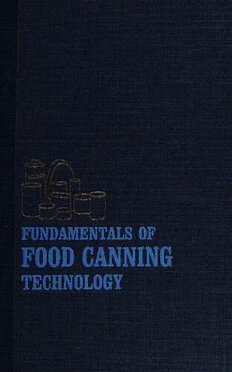
Fundamentals of food canning technology PDF
Preview Fundamentals of food canning technology
FUNDAMENTALS OF FOOD CANNING TECHNOLOGY 1\ 2/3 Receiving raw product Soaking and Washing Sorting and grading Cooling Labeling Warehousing and Packing FUNDAMENTALS OF FOOD CANNING TECHNOLOGY John M. Jackson, Ph.D. Lakeside, Michigan Byron M. Shinn Western Springs, Illinois ® AVI PUBLISHING COMPANY, INC. Westport, Connecticut 1167744. © Copyright 1979 by THE AVI PUBLISHING COMPANY, INC. Westport, Connecticut All rights reserved. No part of this work covered by the copyright hereon may be reproduced or used in any form or by any means—graphic, electronic, or mechanical, including photocopying, recording, taping, or information storage and retrieval systems—without written permission of the publisher. Library of Congress Cataloging in Publication Data Fundamentals of food canning technology. Includes index. 1. Canning and preserving. I. Jackson, John Mathews, 1908- II, Shinn, Byron M. TP371.3.F86 664’.0282 79-10923 ISBN 0-87055-257-0 Printed in the United States of America a) 664.0282 Fq8l Preface The purpose of this book is to present the specialized theory and practice of canning technology in one concise volume. It should be of value to students who are starting to explore this field and to oper- ating technologists who may wish to expand their knowledge into phases of canning technology outside of their immediate areas of specialization. The bibliographies at the conclusion of each of the chapters will be valuable to those who wish to study the subjects involved more thoroughly. Canned foods have become a major factor in the food industry in the United States, constituting a sizable and important portion of the diet. They are stable, not requiring refrigeration, and are easily transported; thus, making it possible for the consuming public to have a varied and nutritious diet at all seasons of the year and all geographical locations. There is a tremendous potential for growth of the industry in Europe and much of the rest of the world. The safeguards required to assure the safety and quality of canned foods are not generally recognized and require specialized study. It is therefore important for students and food technologists to have basic understanding of the principles of this unique method of food preservation. The main factors in canned food preservation are heat steriliza- tion and hermetic protective packaging. Heat sterilization is truly the key-stone of successful canning. The rather complicated mathe- matical analysis of heat penetration and thermal death times of spoilage microorganisms is presented in a lucid manner by two of the experts in this field in Chapter 2. Both rigid metal and glass containers have been used for canned products since the inception of this procedure. They are described in separate chapters by knowledgeable authors. Hermetic flexible Vv vi FUNDAMENTALS OF FOOD CANNING TECHNOLOGY packages, or pouches, have come into use for canned foods rather recently. This development, including testing procedures, is discus- sed at length in Chapter 5 by one of the outstanding experts in this field. Canning procedures for typical products in selected classifications are discussed in chapters 6 through 12 by authors who have had experience with these products. These presentations are intended to give general descriptions of the procedures, but not necessarily to give detailed recipes. Chapter 13 returns to the generalized discussion of the procedures applicable to all types of canned products with regard to coding, labeling, storage and distribution. Consumer demands and govern- mental regulations require close attention to the safety and quality of canned foods. Hazard analysis and quality assurance are pre- sented in Chapter 14 largely from experience in the United States, but the principles are applicable worldwide. Control of waste dis- posal and restriction of water usage are industry-wide problems that are reviewed in Chapter 15. Basic principles are stressed. The concluding chapter summarizes the observations of industrial and academic studies on the nutrient content of canned foods and the factors that are important to achieve maximum retention of these nutrients. . The Appendix contains numerous tables concerning the economic significance of the industry and useful technical data. The Editors are grateful to the several authors who have shared their expert knowledge in contributed chapters. Several members of the staff of the Barrington Technical Center, American Can Company, Barrington, Illinois, have furnished helpful information. The staff of the National Food Processors Association (formerly National Canners Association) has supplied much helpful informa- tion. We are indebted to Whirlpool Corporation for the privilege of using the Information Facilities at the Elisha Gray, II, Research and Engineering Center, Benton Harbor, Michigan. We appreciate the assistance of Mrs. Jean Garrison in typing large portions of the manuscript. And, finally, the encouragement and assistance of Dr. Norman W. Desrosier, Fredric Winters and Lisa E. Melilli of the AVI Publishing Company are gratefully acknowledged. JOHN M. JACKSON BYRON M. SHINN January 1979
